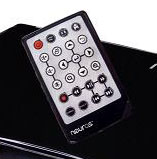This article is more than 1 year old
Neuros MPEG 4 Recorder 2
The no-frills PVR is revamped for the PSP and iPod
The screen now presents six 'tabs': Photos, Music, Video Playback, Video Recording, Settings and a File Browser, all identified by icons along the top of the screen. You use the right and left arrow keys on the remote to cycle through them, pressing the Return button to access each tab's items, such as a list of the folders holding videos. The exception, perhaps, is the Video Recording tab, which initially provides a much-reduced live preview of the source. Pressing return replaces the UI with a full-screen preview, overlayed with the time, encoding quality, and so forth. Pressing the remote's menu key brings up a second screen, this time with relevant settings, such as recorded image size and quality, and timed recording schedules. These are not replicated in the general Settings tab.

As before, the recorder offers MP3 playback and photo presentations, but its real focus is video recording, so I tried that first. The UI's video recording 'tab' presents a handy preview of the source, but you have to press Enter on the remote to go into the video recording section in order to call up the appropriate settings panel to choose the encoded video's size and picture quality. There's the usual 320 x 240 resolution on offer, to which the Recorder 2 adds PSP-friendly 368 x 208 (aka WQVGA) - though the device's display resolution is higher than this - and 640 x 480 for TV playback.
It's a little confusing at first, because 640 x 480 recordings are saved in a folder called TV, while all the other formats end up in a folder labelled MVP. When you're ready to start recording, just press the standard red record button. To stop, press the record button again - there's no Stop key.
Going back to the original recorder's limited ability to operate as a PVR, the new model not only sports larger image size, but has a timer facility too. It's not quite TiVo, but it does the job. There are four quality settings: Super Fine, Fine, Normal and Economy. Essentially, they're bit-rate settings for the device's MPEG 4 encoder: 2Mbps, 1Mbps, 768Kbps and 384Kbps, respectively. Switching to either QVGA or WQVGA limits your bit-rate choice to either Normal or Economy - unsurprising, as the PSP can't play back anything higher than 768Kbps. The player also creates the .THM thumbnail files used by the PSP's menu system to display content previews.
The MPEG 4 Recorder defaults to NTSC output, but you can easily switch it to PAL in the Settings tab. Mac users should note that the player nicely ignores metafiles created when its memory card is read by Mac OS X's Finder.
The device's recording results are good, and while anything less than Super Fine doesn't make for an ideal TV experience, at least you can sacrifice visual fidelity to maximise the available storage, if you wish. The only thing I didn't like was the way the frame was cropped when I was recording to WQVGA format, with not only the lower black bar of the letterbox image removed, but some of the picture too.
